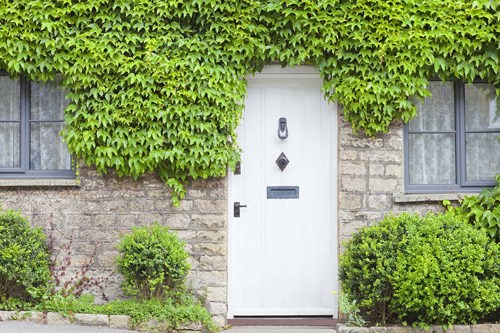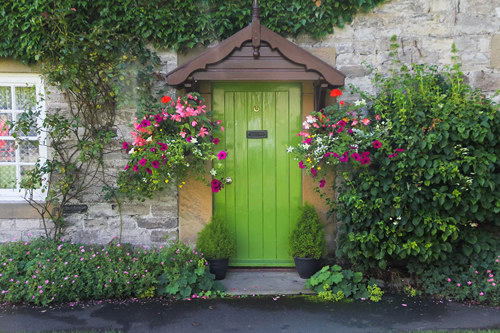Cottage front door ideas with planters
Planters are an easy, low-cost way to add greenery to any doorway. Almost any container can be turned into a planter, provided that it has sufficient drainage.
Arrange mismatched planters in clusters around your front door, and choose a selection of plants with different heights, colours and textures for year-round interest.
Traditional terracotta pots and troughs
A traditional cottage front door will use natural materials, so terracotta pots and troughs are perfect for this, giving a more rustic look. Arrange your pots in asymmetrical clusters, groups of three are often recommended, or position your trough against the wall of your porch.
Terracotta is cost effective and it’s breathable, which keeps soil healthy, and porous, which means that it’s best used for plants that prefer drier soil.
Lavender, with its fragrant purple blooms, can grow in containers. It prefers a warm, sunny spot. Choose English lavender for a subtle scent and a variety of flower colours available, from dark purple to even pink.
Hydrangeas also do well in terracotta pots, but note when container-grown they require regular watering. Best known for their large, colourful flowerheads, hydrangeas have long-lasting blooms and traditional cottage charm. Mophead varieties have large, pom-pom-like flowerheads, while lacecaps have a cone-like shape. Both prefer sheltered, sunny doorways. As perennials, they’ll return at the end of the season with little upkeep. It's a permanent addition to the garden, and it will continue to grow well in containers.
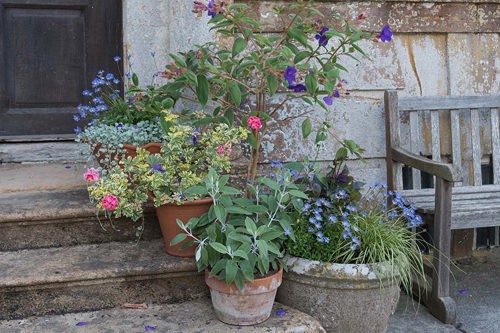
Fresh, fragrant herbs are a key part of the cottage aesthetic. Low-maintenance rosemary grows best in a sunny doorway and will flourish in a terracotta container. Use its aromatic, needle-shaped leaves in your cooking, and enjoy its pink, white or blue flowers in the spring and summer.
Rustic wooden crates and baskets
Cottage gardens are all about upcycling, so if you have old wooden crates or wicker baskets, you can put them to new use as rustic planters for your front door.
Make sure there’s good drainage at the bottom of your crate, and line it with burlap or a plastic liner, ensuring there’s holes at the base. Consider adding crocks (broken pieces of pot) to help with drainage, fill it with compost, and you’re good to go.
Wooden planters are extremely versatile, so your choice of plants will come down to the size of your crate or basket and the position of your doorway. For a front door display that will look good all year round, consider growing seasonal plants. A mix of spring bulbs, such as daffodils, tulips and crocuses, will brighten a sunny doorway. Plant them in Autumn and they’ll bloom in spring. Deadhead them after they've flowered, move the container or replant the bulbs elsewhere until the following spring.
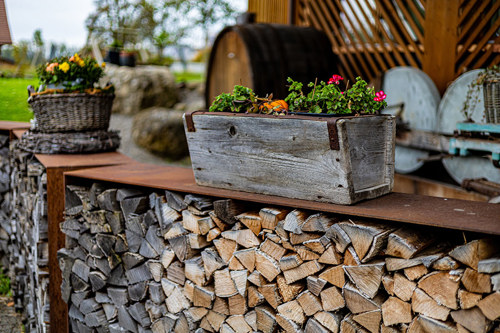
For flowers during the summer, look for perennial patio plants. Plant them in the spring and they’ll flower throughout the summer and die back in the winter, before returning the following year. For life and colour, vibrant blooms like dahlias, fuchsia, geraniums or begonias are good options. Add trailing varieties like ivy-leaf pelargoniums or Surfinia petunia cultivars to cascade over the sides of your basket or crate.
During cold, grey winters, hardy plants like cyclamen, hellebore, bergenia and Skimmia japonica can bring bursts of colour to your doorstep. As evergreens, they’ll produce flowers in the winter and spring, but their foliage will provide year-round interest. Cyclamen, for example, have beautiful heart-shaped leaves with delicate vein markings, while Bergenia, which flower in spring, have large, glossy leaves that change colour with the seasons.
Climbing plants and creepers to frame the door
“A cottage garden will use every available space for plants,” says Domoney. “With a doorway, your walls and brickwork are all part of your canvas.”
Using trellises, arbours or arches to add climbing plants to your doorway will add vertical interest and increase your potential to grow. There are other benefits too. Adding climbing plants to your doorway can help provide privacy, as well as helping to control the temperature of your home. In the summer, they keep it cool by creating shade, while in the winter, they provide extra insulation.
Green living walls are also fantastic for biodiversity. They are important habitats for birds and insects, while bees and butterflies flock to pollen-filled flowers. Plants’ leaves can even help to absorb pollution, bringing air-purifying benefits to your entrance.
Honeysuckle, roses, wisteria and jasmine, for example, are classic cottage climbers, giving guests a wonderful fragrant welcome to your home. Whether you prefer showy blooms or understated foliage plants, there are plenty of options for your front door.
English climbing roses (Rosa), clematis and wisteria
Climbing roses are some of the most versatile types of roses available, and they come in a huge range of colours, sizes and flower patterns. ‘Claire Austin’ varieties, for example, are fragrant with cream-coloured flowers. Once you’ve made your choice, roses can last for many years.
Climbing roses need moist, fertile soil and regular watering in warm weather. Most prefer a sunny spot, but there are also varieties that will grow in shadier north-facing doorways. “Clematis are social climbers, and pair well with roses,” says Domoney. “They are extremely adaptable and will climb up any surface you give them. They can be cultivated into great shapes too.”
These keen climbers are known for their range of big, beautiful flowers. The ‘Princess Diana’, for example, has pink, tulip-shaped flowers, while the ‘Etoile Violette’ has violet blooms with yellow stamens. There is a clematis for every type of doorway, whether it is sunny or shaded, and varieties which will flower from spring through to autumn. Most are easy-to-grow and should be kept in a sunny or partially shaded spot, with their roots kept cool, moist and well-fertilised.
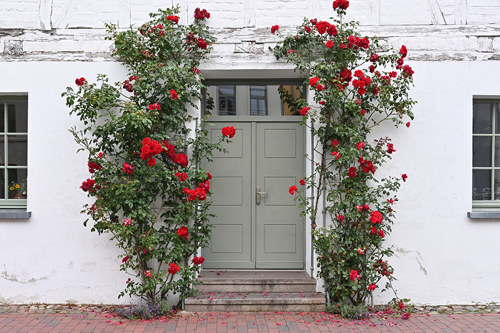
Wisteria, with its long, hanging branches of purple flowers, is a cottage garden staple. It is a vigorous climber, and flowers in late spring and early summer. The more sun it gets, the more flowers it will grow.
Evergreen options: ivy or jasmine
For a climber that will look good all year round, consider ivy or jasmine.
Summer-flowering jasmines have the rich, floral fragrance that the plant is known for.
Ivies grow well in almost any location, whether shaded or sunny. Some forms, though, are more vigorous than others. Look for climbing varieties like ‘Sulphur Heart’, which has large, heart-shaped green leaves which look like they’ve been splashed with yellow or a lighter shade of green. These patterns strengthen as the plant matures. ‘Glacier’ is ornamental, with pale green leaves with cream edges.
